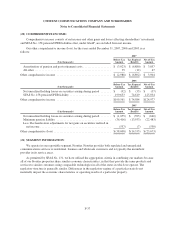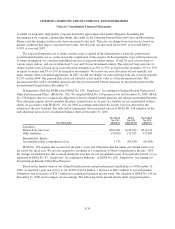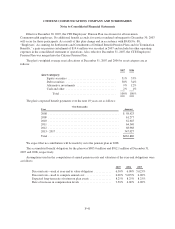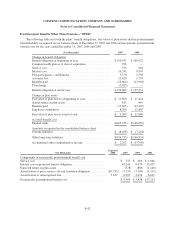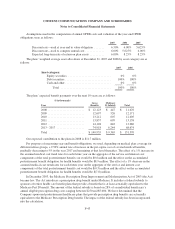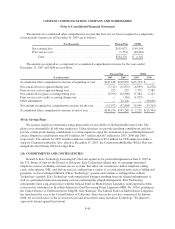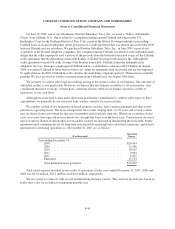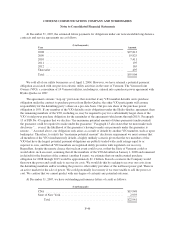Frontier Communications 2007 Annual Report Download - page 96
Download and view the complete annual report
Please find page 96 of the 2007 Frontier Communications annual report below. You can navigate through the pages in the report by either clicking on the pages listed below, or by using the keyword search tool below to find specific information within the annual report.
CITIZENS COMMUNICATIONS COMPANY AND SUBSIDIARIES
Notes to Consolidated Financial Statements
At December 31, 2007, the estimated future payments for obligations under our noncancelable long distance
contracts and service agreements are as follows:
($ in thousands)
Year Amount
2008 ..................................................... $27,813
2009 ..................................................... 19,825
2010 ..................................................... 7,411
2011 ..................................................... 195
2012 ..................................................... 165
Thereafter ................................................. 495
Total ..................................................... $55,904
We sold all of our utility businesses as of April 1, 2004. However, we have retained a potential payment
obligation associated with our previous electric utility activities in the state of Vermont. The Vermont Joint
Owners (VJO), a consortium of 14 Vermont utilities, including us, entered into a purchase power agreement with
Hydro-Quebec in 1987.
The agreement contains “step-up” provisions that state that if any VJO member defaults on its purchase
obligation under the contract to purchase power from Hydro-Quebec the other VJO participants will assume
responsibility for the defaulting party’s share on a pro-rata basis. Our pro-rata share of the purchase power
obligation is 10%. If any member of the VJO defaults on its obligations under the Hydro-Quebec agreement, then
the remaining members of the VJO, including us, may be required to pay for a substantially larger share of the
VJO’s total power purchase obligation for the remainder of the agreement (which runs through 2015). Paragraph
13 of FIN No. 45 requires that we disclose “the maximum potential amount of future payments (undiscounted)
the guarantor could be required to make under the guarantee.” Paragraph 13 also states that we must make such
disclosure “… even if the likelihood of the guarantor’s having to make any payments under the guarantee is
remote…” As noted above, our obligation only arises as a result of default by another VJO member, such as upon
bankruptcy. Therefore, to satisfy the “maximum potential amount” disclosure requirement we must assume that
all members of the VJO simultaneously default, a highly unlikely scenario given that the two members of the
VJO that have the largest potential payment obligations are publicly traded with credit ratings equal to or
superior to ours, and that all VJO members are regulated utility providers with regulated cost recovery.
Regardless, despite the remote chance that such an event could occur, or that the State of Vermont could or
would allow such an event, assuming that all the members of the VJO defaulted on January 1, 2008 and remained
in default for the duration of the contract (another 8 years), we estimate that our undiscounted purchase
obligation for 2008 through 2015 would be approximately $1.1 billion. In such a scenario the Company would
then own the power and could seek to recover its costs. We would do this by seeking to recover our costs from
the defaulting members and/or reselling the power to other utility providers or the northeast power grid. There is
an active market for the sale of power. We could potentially lose money if we were unable to sell the power at
cost. We caution that we cannot predict with any degree of certainty any potential outcome.
At December 31, 2007, we have outstanding performance letters of credit as follows:
($ in thousands)
CNA ..................................................... $19,948
State of New York .......................................... 2,993
Total ................................................. $22,941
F-46



